
In today’s fast-paced DevOps ecosystem, automation is no longer a luxury — it’s the foundation for speed, scalability, and reliability. Continuous Integration and Continuous Deployment (CI/CD) pipelines play a vital role in accelerating software delivery, yet many organizations still struggle with inefficiencies, manual tasks, and inconsistent environments.
This is where CloudLaunchPad turns the manual into magical — transforming complex, repetitive CI/CD processes into streamlined, automated, and reusable blueprints.
The Pain Behind Manual CI/CD
Before we jump into automation bliss, let’s understand the real-world pain points most DevOps teams face when managing CI/CD pipelines manually:
Pipeline Bottlenecks
- Teams often struggle with slow build and deploy cycles caused by long-running jobs, unoptimized container builds, or inefficient dependency management.
- Shared agents or poorly configured runners lead to queuing delays and inconsistent performance.
Manual Interventions
- Manual approvals or ad-hoc fixes increase risk and reduce reliability.
- Frequent context switching — from fixing YAML syntax to troubleshooting IAM permissions — breaks the developer flow.
- Lack of standardized templates means every new pipeline starts from scratch.
Inconsistent Environments
- Different teams deploy across AWS, Azure, or on-prem systems with varying configurations and tools.
- Without clear IaC and pipeline codification, environment drift becomes inevitable, leading to “it works on my machine” moments.
Lack of Governance and Visibility
- Multiple CI/CD tools (Jenkins, GitLab, GitHub Actions) running in silos cause fragmentation.
- Auditing, logging, and enforcing best practices across all pipelines is nearly impossible without a central control plane.
Introducing CloudLaunchPad: The DevOps Accelerator
CloudLaunchPad is a unified automation framework designed to simplify cloud provisioning, CI/CD standardization, and governance across multi-environment setups.
It empowers DevOps teams to define, launch, and manage CI/CD pipelines — whether on AWS, Azure, or hybrid — with consistency and control.
Unified Abstraction Layer
At its core, CloudLaunchPad provides a consistent abstraction layer across different CI/CD tools. Instead of rewriting pipelines for Jenkins, GitHub Actions, or GitLab, teams can plug into CloudLaunchPad modules that handle:
- Infrastructure provisioning (via Terraform or CDK)
- Environment bootstrapping (VPC, IAM roles, S3 buckets, CodeBuild, etc.)
- CI/CD template generation with predefined policies and naming conventions.
This abstraction means developers focus on application logic, not plumbing.
Integrating CloudLaunchPad with Popular CI/CD Tools
Jenkins
CloudLaunchPad offers Jenkins-ready modules that include:
- Terraform templates for Jenkins master and agent provisioning (EC2, EKS, or ECS-based).
- Predefined pipeline libraries for integrating IaC and application build stages.
- Parameterized pipeline templates for multi-environment deployments.
You can directly integrate CloudLaunchPad modules into Jenkinsfiles using shared libraries, allowing every project to bootstrap a compliant and secure pipeline in minutes.
GitLab CI/CD
For GitLab, CloudLaunchPad integrates through .gitlab-ci.yml templates and reusable jobs.
These templates encapsulate Terraform, Ansible, and Docker build logic with predefined variables and security rules.
GitHub Actions
CloudLaunchPad provides reusable GitHub Action workflows published under the organization’s namespace.
These workflows can be directly invoked using the uses: syntax and automatically enforce tagging, logging, and policy compliance by integrating with GitHub’s OIDC-based authentication. CloudLaunchPad securely assumes IAM roles without storing long-lived AWS credentials.
Tips for Optimizing Pipelines Using CloudLaunchPad
Automation is only powerful when it’s optimized. Here’s how teams can make the most out of CloudLaunchPad’s CI/CD capabilities:
Reuse Modular Blueprints
Every CloudLaunchPad component — whether EKS, Lambda, or API Gateway — is modular and versioned.
This modularity reduces maintenance and ensures standard compliance across environments.
Embed Automated Rollbacks
Integrate CloudLaunchPad’s rollback hooks into pipelines.
If a deployment fails or health checks fail post-deploy, CloudLaunchPad can automatically restore the last successful version from S3 or ECR backups.
Use Environment-Aware Variables
By centralizing environment configuration (Dev, QA, UAT, Prod) in CloudLaunchPad, pipelines dynamically pull correct parameters — such as account IDs, ARNs, and endpoints — preventing misconfiguration.
Integrate with Observability Tools
CloudLaunchPad can push deployment metrics to Datadog, CloudWatch, or Prometheus, enabling visibility into deployment duration, frequency, and success rates.
Enforce Security by Design
Leverage built-in policies for:
- IAM least privilege roles
- Secure S3 storage
- Artifact encryption (KMS)
- Container image scanning via ECR lifecycle rules
This ensures your pipeline isn’t just fast — it’s also secure and compliant.
The CloudLaunchPad Advantage
| Capability | Traditional CI/CD | With CloudLaunchPad |
|---|---|---|
| Pipeline setup | Manual YAML & plugin management | Predefined templates and reusable modules |
| Environment provisioning | Manual IaC scripts | Automated Terraform blueprints |
| Governance | Tool-specific and inconsistent | Centralized policies and controls |
| Multi-cloud support | Limited | AWS, Azure, GCP abstraction layer |
| Security & Compliance | Manual checks | Built-in enforcement |
| Speed | Slow, repetitive setup | 5x faster pipeline launches |
Conclusion
The journey from manual CI/CD to magical automation isn’t about removing control — it’s about reclaiming time and reducing friction.
With CloudLaunchPad, DevOps teams can:
- Launch secure, production-grade pipelines in minutes.
- Standardize across multiple clouds and tools.
- Reduce manual interventions while increasing governance and visibility.
In essence, CloudLaunchPad is not just a framework — it’s a DevOps accelerator, enabling teams to focus on innovation rather than integration.


